by Calculated Risk on 7/31/2011 10:39:00 PM
Sunday, July 31, 2011
Sunday Night Futures
Although the debt ceiling deal has been announced, we still need to see the details to evaluate the drag on the economy. And the bill still needs to pass the House and Senate.
Hopefully the focus can be back on the economy (instead of D.C.) Unfortunately the economic data for July will be weak. The economy is still sluggish, and the "debate" itself was negatively impacting the economy over the last few weeks as some people feared the U.S. government would not pay its bills. Although that fear was unfounded, it is pretty clear there will be no additional stimulus, no further help for the unemployed, and no extension of the payroll tax cut.
Here is the economic schedule for coming week. The key report for this week will be the July employment report to be released on Friday, August 5th.
The Asian markets are green tonight with the Nikkei up almost 2%.
From CNBC: Pre-Market Data and Bloomberg futures: the S&P 500 is up about 15 points, and Dow futures are up about 175 points.
Oil: WTI futures are up to $97.41 and Brent is up to $118.23.
Yesterday:
• Summary for Week ending July 29th
Another Debt Ceiling Update
by Calculated Risk on 7/31/2011 06:58:00 PM
The details are still murky ...
UPDATE2: WSJ: Obama Says Congressional Leaders Have Agreed to a Debt Deal
Update: The WSJ reports:
House Republican leaders have agreed to a “tentative deal” ... House leaders have scheduled a briefing for their caucus at 8:30, aides say.From the WSJ:
* $900 billion in the first stage of deficit reduction.From the WaPo: Reid hopes for vote on deal Sunday night
* $1.5 trillion in second stage of deficit reduction to be defined by a bipartisan special committee of lawmakers appointed by leaders of the House and Senate.
* If the special committee fails to deliver a deficit-cutting package that would trigger $1.2 trillion in cuts, half would be Defense cuts and the other half would be non-Defense cuts, exempting low-income programs Social Security and Medicaid, and only impacting providers in Medicare.
* The debt ceiling increase would be done in three phases: $400 billion initially; another $500 billion later this year would be subject to a vote of disapproval; a third increase of $1.5 to get the rest through 2012 and would also be subject to vote of disapproval.
* There is also a provision to have Congress vote on balanced budget amendment.
From the NY Times: Reid Backs Debt Deal; Defense Cuts Still in Debate
Apparently Boehner is balking at the defense cuts. The idea behind the triggers is to make people take the recommendations of the special committee seriously. Unless the triggers are unpalatable to both sides, the commission will fail (I suspect it is already doomed).
The multiple votes are for more posing (shameful, but typical politics).
Yesterday:
• Summary for Week ending July 29th
• Schedule for Week of July 31st
Problem Banks: Comparing Official and Unofficial Counts
by Calculated Risk on 7/31/2011 03:41:00 PM
The following graph compares the weekly count of banks on the "unofficial problem bank list" with the number from the FDIC's Quarterly Banking Profile.
We started posting the Unofficial Problem Bank list in early August 2009 (credit: surferdude808).
The FDIC's official problem bank list is comprised of banks with a CAMELS rating of 4 or 5, and the list is not made public (just the number of banks and assets every quarter). Note: Bank CAMELS ratings are also not made public.
CAMELS is the FDIC rating system, and stands for Capital adequacy, Asset quality, Management, Earnings, Liquidity and Sensitivity to market risk. The scale is from 1 to 5, with 1 being the strongest.
As a substitute for the CAMELS ratings, surferdude808 is using publicly announced formal enforcement actions, and also media reports and company announcements that suggest to us an enforcement action is likely, to compile a list of possible problem banks in the public interest.
The red dots are the number of banks on the official problem bank list as announced in the FDIC quarterly banking profile for Q1 2009 through Q1 2011. The dots are lagged one month because of the delay in announcing formal actions. Here is a graph from the FDIC back to Q1 2006.
On August 7, 2009, we listed 389 institutions with $276 billion in assets, and the list now has 995 institutions and $415 billion in assets.
For Q1 2011, the FDIC listed 888 institutions and $390 billion in assets (somewhat less than the unofficial list a month later). The FDIC Q2 2011 Quarterly Banking Profile will be released in a few weeks.
The unofficial count is close, but is somewhat higher than the official count.
Yesterday:
• Summary for Week ending July 29th
• Schedule for Week of July 31st
Debt Ceiling Update
by Calculated Risk on 7/31/2011 12:18:00 PM
The final vote will probably be on Tuesday to maximize camera time ...
From the WSJ:
The White House and negotiators for congressional leaders of both parties are pushing for a deal that would raise the nation’s borrowing limit in tandem with deficit reduction in a two-stage process that could result in as much as $3 trillion in spending cuts over the next decade, lawmakers said Sunday.The details sketchy are still sketchy, so it is difficult to tell how much of a drag this plan will be on the economy.
The terms of the second phase – which would link further borrowing leeway to a potentially far-reaching overhaul of the tax code, defense spending and the major old-age safety net programs – are still not decided, leaders of both parties said in appearances on Sunday morning news programs.
On a personal note, I think most Americans (and most politicians) do not understand the U.S. budget. This reminds me of the housing bubble - it seemed obvious to many of us, but most Americans (and most politicians) missed it completely. As an example, the "Balanced Budget Amendment" is obviously bad policy, yet politicians aren't ridiculed for supporting it. Immediate cuts with a 9.2% unemployment rate are bad policy, but that appears to be what is going to happen. I wish I was a better writer ... but I'll try to explain why these are policy mistakes in the months ahead.
Update: here is what I wrote in the comments:
I get really frustrated with politicians comparing the Federal budget to a family budget. The government does not have a capital budget, so if they spend money on R&D or roads, that is just included in the budget.
If a family buys a car with 5 year financing, they usually just budget the monthly payments. If they budgeted like the government, they'd have to include the entire purchase of the car the year it was bought (same with a house - they'd have to enough to pay cash to buy the house).
Some people compare to the states too. Hey the states are supposed to have balanced budgets. But states have separate capital and operating budgets. I think people just don't understand.
...
A politician can say "We should have a balanced budget". It sounds good, but why aren't they challenged about operating vs. capital budgets? And about business cycle spending (obviously revenue falls during a recession - and spending increases)?
What they really want is a balanced operating budget over the business cycle. You can't put that in the Constitution. It requires effective government and constant vigilance.
Of course in 2001, when the politicians were concerned about paying off the debt too soon, that nonsense went mostly unchallenged too. Very frustrating.
I need to think about how to explain it. "Balanced budget" sounds so good, and is so wrong.
Restaurant Performance Index increases in June
by Calculated Risk on 7/31/2011 08:15:00 AM
From the National Restaurant Association: Restaurant Industry Outlook Strengthened in June as Restaurant Performance Index Rose Above 100
Driven by stronger same-store sales and traffic levels and a more optimistic outlook among restaurant operators, the National Restaurant Association’s Restaurant Performance Index (RPI) rose above 100 in June. The RPI – a monthly composite index that tracks the health of and outlook for the U.S. restaurant industry – stood at 100.6 in June, up 0.8 percent from May’s level of 99.9. In addition, June represented the sixth time in the last seven months that the RPI stood above 100, which signifies expansion in the index of key industry indicators.
“The RPI’s solid improvement in June was due in large part to stronger same-store sales and customer traffic performances, which bounced back from their May declines,” said Hudson Riehle, senior vice president of the Research and Knowledge Group for the Association. “In addition, restaurant operators are optimistic that their sales environment will improve in the months ahead, while their outlook for capital spending also remains strong.”
...
Restaurant operators reported stronger same-store sales results in June. ... Restaurant operators also reported improving customer traffic levels in June.
 Click on graph for larger image in graph gallery.
Click on graph for larger image in graph gallery.The index increased to 100.6 in June (above 100 indicates expansion).
Unfortunately the data for this index only goes back to 2002.
This is a minor report (barely "D-List" data), but I'd expect discretionary spending to slow sharply if consumers become really worried - and that doesn't seem to be happening.
Next Senate Vote at 1 PM ET Sunday
by Calculated Risk on 7/31/2011 12:17:00 AM
From the NY Times: Amid New Talks, Some Optimism on Debt Crisis
Senator Harry Reid ... said he would convene the Senate at noon on Sunday for a vote an hour later.The vote will probably be delayed some more ... and then maybe fail in the House on the first vote. But eventually the debt ceiling will be raised.
Earlier:
• Summary for Week ending July 29th
• Schedule for Week of July 31st
Saturday, July 30, 2011
Random Thoughts
by Calculated Risk on 7/30/2011 09:14:00 PM
• I remain confident that Congress will raise the debt ceiling; however the circus in D.C. is clearly impacting the economy. This morning I spoke to a business owner who is negotiating a new lease to expand. His lawyer told him not to sign the lease until the debt ceiling issue is resolved. I believe similar caution has gripped business owners and consumers in many places - and impacting consumer and business confidence.
• Some people have asked why Q2 GDP growth was higher than Q1 GDP growth given the supply chain disruptions hit in Q2. The answer is both quarters were weak, but there was slightly more investment in Q2, less drag from government spending in Q2, and a positive contribution from trade. Inflation was lower in Q2 too, so the adjustment to real GDP was less.
The supply chain disruptions really showed up in Personal Consumption Expenditures (PCE) in Q2. PCE contributed almost nothing to Q2 growth; PCE increased at a 0.1% annualized real rate in Q2, after increasing at an anemic 2.1% in Q1. PCE should bounce back in Q3 - so real GDP growth will probably pick up. Well, if the politicians stop hurting the already fragile economy.
• I'm trying to ignore the debt ceiling nonsense, but it will probably be front page news for the next few days - so it will be difficult to avoid. Ezra Klein at the WaPo is providing excellent coverage, and the Capital Gains and Games blog has some great insights. (I expect Ezra will be working Sunday).
If you think Congress will fail to raise the debt ceiling, I'd suggest Tar and Feather futures!
Earlier:
• Summary for Week ending July 29th
• Schedule for Week of July 31st
Schedule for Week of July 31st
by Calculated Risk on 7/30/2011 04:58:00 PM
Earlier:
• Summary for Week ending July 29th
The key report for this week will be the July employment report to be released on Friday, August 5th. The ISM manufacturing report will be released on Monday, and the ISM non-manufacturing report on Wednesday. Also the automakers report July vehicle sales on Tuesday.
Note: It is unclear if the employment report will be delayed if Congress fails to raise the debt ceiling (government employees could continue working without pay).
10:00 AM ET: ISM Manufacturing Index for July. The consensus is for a decrease to 54.3 from 55.3 in June.
10:00 AM: Construction Spending for June. The consensus is for no change in construction spending.
8:30 AM: Personal Income and Outlays for June. The consensus is for a 0.2% increase in personal income in June, and a 0.1% increase in personal spending, and for the Core PCE price index to increase 0.2%. The revisions will show significantly lower consumption earlier this year.
All day: Light vehicle sales for July. Light vehicle sales are expected to increase to 11.9 million (Seasonally Adjusted Annual Rate), from 11.4 million in June.
 This graph shows light vehicle sales since the BEA started keeping data in 1967. The dashed line is the June sales rate.
This graph shows light vehicle sales since the BEA started keeping data in 1967. The dashed line is the June sales rate. Edmunds is forecasting: "Toyota appears to be well on its way toward recovery following its new car sales and inventory struggles over the past few months, according to Edmunds.com’s July 2011 U.S. automotive sales forecast.
...
Edmunds.com estimates ... a Seasonally Adjusted Annualized Rate (SAAR) of 12.3 million light vehicles, nearly one million more than the 11.4 million SAAR reported in June."
7:00 AM: The Mortgage Bankers Association (MBA) will release the mortgage purchase applications index. This index has been very weak over the last couple months suggesting weak home sales through summer (not counting all cash purchases).
8:15 AM: The ADP Employment Report for July. This report is for private payrolls only (no government). The consensus is for +100,000 payroll jobs in July, down from the +157,000 reported in June.
 10:00 AM: ISM non-Manufacturing Index for July. The consensus is for a slight increase to 54.0 in July.
10:00 AM: ISM non-Manufacturing Index for July. The consensus is for a slight increase to 54.0 in July. This graph shows the ISM non-manufacturing index (started in January 2008) and the ISM non-manufacturing employment diffusion index. The June ISM Non-manufacturing index was at 53.3%, down from 54.6% in May. The employment index increased in June to 54.1%, up from 54.0% in May. Note: Above 50 indicates expansion, below 50 contraction.
10:00 AM: Manufacturers' Shipments, Inventories and Orders for June (Factory Orders). The consensus is for a 1.0% decrease in orders.
8:30 AM: The initial weekly unemployment claims report will be released. The consensus is for an increase to 403,000 from 398,000 last week.
8:30 AM: Employment Report for July.
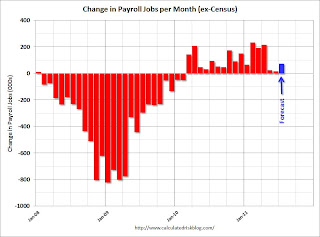 The consensus is for an increase of 75,000 non-farm payroll jobs in July, up from the 18,000 jobs added in June. I'll take the under.
The consensus is for an increase of 75,000 non-farm payroll jobs in July, up from the 18,000 jobs added in June. I'll take the under.This graph shows the net payroll jobs per month (excluding temporary Census jobs) since the beginning of the recession. The consensus forecast for July is in blue.
The consensus is for the unemployment rate to hold steady at 9.2% in July.
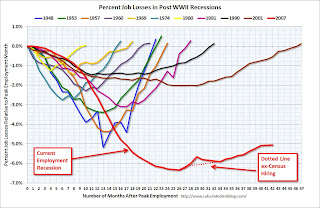 This second employment graph shows the percentage of payroll jobs lost during post WWII recessions. This shows the severe job losses during the recent recession.
This second employment graph shows the percentage of payroll jobs lost during post WWII recessions. This shows the severe job losses during the recent recession. Through the first six months of 2011, the economy has added 757,000 total non-farm jobs or just 126 thousand per month. There have been 945,000 private sector jobs added, or about 158 thousand per month. This is a better pace of payroll job creation than last year, but the economy still has 6.98 million fewer payroll jobs than at the beginning of the 2007 recession.
3:00 PM: Consumer Credit for June. The consensus is for a $5.1 billion increase in consumer credit.
Summary for Week ending July 29th
by Calculated Risk on 7/30/2011 10:45:00 AM
The big economic story of the week was the Q2 GDP release. The Bureau of Economic Analysis (BEA) reported that real GDP growth increased a sluggish 1.3% annualized in Q2, and that growth was revised down to just 0.4% in Q1. Also the revisions indicated the recession was significantly worse than in earlier estimates.
On the political front, the U.S. government is still working towards raising the debt ceiling by this coming Tuesday. There are clear indications that the discussions in Washington have negatively impacted the economy over the last couple of weeks. Goldman Sachs economists write last night that their forecasts for ‘growth in Q4 and 2012 are under review for probably downgrade’. They argued the dysfunction in Washington is impacting confidence: “The inability of policymakers to agree on a measure to lift the federal debt ceiling has damaged consumer confidence, not to mention our own confidence ..."
In other news, sales of new homes are still moving sideways – and house prices, according to Case-Shiller, increased seasonally in May. The regional manufacturing surveys were slightly stronger in July than in June – but that isn’t saying much. Overall the economy remains very sluggish.
Here is a summary in graphs:
• New Home Sales in June at 312,000 Annual Rate
 Click on graph for larger image in graph gallery.
Click on graph for larger image in graph gallery.
The Census Bureau reported New Home Sales in June were at a seasonally adjusted annual rate (SAAR) of 312 thousand. This was down from a revised 315 thousand in May (revised from 319 thousand).
The first graph shows New Home Sales vs. recessions since 1963. The dashed line is the current sales rate.
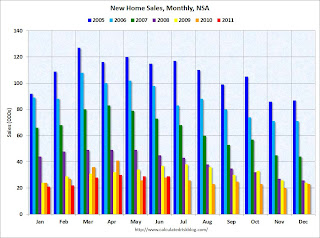 This graph shows sales NSA (monthly sales, not seasonally adjusted annual rate).
This graph shows sales NSA (monthly sales, not seasonally adjusted annual rate).
In June 2011 (red column), 29 thousand new homes were sold (NSA). The record low for June was 28 thousand in 2010 (following the expiration of the homebuyer tax credit). The high for June was 115 thousand in 2005.
This was below the consensus forecast of 321 thousand, and was just above the record low for the month of June - and new home sales have averaged only 300 thousand SAAR over the 14 months since the expiration of the tax credit ... moving sideways at a very low level.
• Case Shiller: Home Prices increase in May
 From S&P: Some More Seasonal Improvement in Home Prices
From S&P: Some More Seasonal Improvement in Home Prices
This graph shows the nominal seasonally adjusted Composite 10 and Composite 20 indices (the Composite 20 was started in January 2000).
The Composite 10 index is off 31.8% from the peak, and up slightly in May (SA). The Composite 10 is 1.7% above the May 2009 post-bubble bottom (Seasonally adjusted).
The Composite 20 index is off 31.8% from the peak, and down slightly in May (SA). The Composite 20 is slightly above the March 2011 post-bubble bottom seasonally adjusted.
 Here are the price declines from the peak for each city included in S&P/Case-Shiller indices.
Here are the price declines from the peak for each city included in S&P/Case-Shiller indices.
Prices increased (SA) in 9 of the 20 Case-Shiller cities in May seasonally adjusted. Prices in Las Vegas are off 59% from the peak, and prices in Dallas only off 9.5% from the peak.
From S&P (NSA):
As of May 2011, 16 of the 20 MSAs and both Composites posted positive monthly changes. Phoenix was flat. Detroit, Las Vegas and Tampa were the markets where levels fell in May versus April, with Detroit down by 2.8% and Las Vegas posting its eighth consecutive monthly decline. These three cities also posted new index level lows in May 2011. They are now 51.2%, 59.3% and 47.5% below their 2005-6 peak levels, respectively.• Real House Prices and Price-to-Rent
Case-Shiller, CoreLogic and others report nominal house prices. However it is also useful to look at house prices in real terms (adjusted for inflation), as a price-to-rent ratio, and also price-to-income (not shown here).
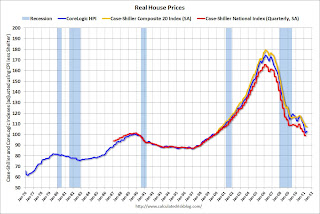 This graph shows the quarterly Case-Shiller National Index SA (through Q1 2011), and the monthly Case-Shiller Composite 20 SA (through May) and CoreLogic House Price Indexes (through May) in real terms (adjusted for inflation using CPI less Shelter). Note: some people use other inflation measures to adjust for real prices.
This graph shows the quarterly Case-Shiller National Index SA (through Q1 2011), and the monthly Case-Shiller Composite 20 SA (through May) and CoreLogic House Price Indexes (through May) in real terms (adjusted for inflation using CPI less Shelter). Note: some people use other inflation measures to adjust for real prices.In real terms, the National index is back to Q4 1999 levels, the Composite 20 index is back to August 2000, and the CoreLogic index back to March 2000. In real terms, all appreciation in the last decade is gone.
 In October 2004, Fed economist John Krainer and researcher Chishen Wei wrote a Fed letter on price to rent ratios: House Prices and Fundamental Value. Kainer and Wei presented a price-to-rent ratio using the OFHEO house price index and the Owners' Equivalent Rent (OER) from the BLS.
In October 2004, Fed economist John Krainer and researcher Chishen Wei wrote a Fed letter on price to rent ratios: House Prices and Fundamental Value. Kainer and Wei presented a price-to-rent ratio using the OFHEO house price index and the Owners' Equivalent Rent (OER) from the BLS.Here is a similar graph using the Case-Shiller Composite 20 and CoreLogic House Price Index (through May). This graph shows the price to rent ratio (January 1998 = 1.0). On a price-to-rent basis, the Composite 20 index is back to October 2000 levels, and the CoreLogic index is back to March 2000.
For more on home sales and house prices, here are the previous posts:
On June Home Sales:
• New Home Sales in June at 312,000 Annual Rate
• Existing Home Sales in June: 4.77 million SAAR, 9.5 months of supply
• Home Sales: Distressing Gap
• Graph Galleries: New Home Sales and Existing Home Sales
On House Prices:
• Case Shiller: Home Prices increase in May
• Real House Prices and Price-to-Rent
• Graph Galleries: Home Prices
• Advance Estimate: Real Annualized GDP Grew at 1.3% in Q2
Note: This release contained a number of revisions. The recession was significantly worse than in earlier estimates. Last quarter (Q1) was revised down to just 0.4% real GDP growth.
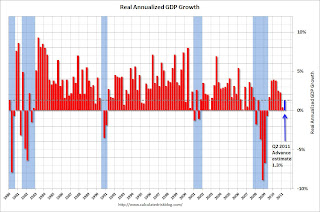 This graph shows the quarterly GDP growth (at an annual rate) for the last 30 years. The dashed line is the current growth rate. Growth in Q2 at 1.3% annualized was below trend growth (around 3.1%) - and very weak for a recovery, especially with all the slack in the system.
This graph shows the quarterly GDP growth (at an annual rate) for the last 30 years. The dashed line is the current growth rate. Growth in Q2 at 1.3% annualized was below trend growth (around 3.1%) - and very weak for a recovery, especially with all the slack in the system.Not only has growth slowed, but the recession was significantly worse than earlier estimates suggested.
The following graph is constructed as a percent of the previous peak. This shows when GDP has bottomed - and when GDP has returned to the level of the previous peak. If the indicator is at a new peak, the value is 100%.
 This graph is for real GDP through Q2 2011 and shows real GDP is still 0.4% below the previous pre-recession peak. At the worst point, real GDP was off 5.1% from the 2007 peak. Since the most common definition of a depression is a 10%+ decline in real GDP, the 2007 recession was not a depression. Note: There is no formal definition of a depression. Some people use other definitions such as the duration below the previous peak. By that definition, using both GDP and employment, this seems like the "Lesser depression", but not by the common definition.
This graph is for real GDP through Q2 2011 and shows real GDP is still 0.4% below the previous pre-recession peak. At the worst point, real GDP was off 5.1% from the 2007 peak. Since the most common definition of a depression is a 10%+ decline in real GDP, the 2007 recession was not a depression. Note: There is no formal definition of a depression. Some people use other definitions such as the duration below the previous peak. By that definition, using both GDP and employment, this seems like the "Lesser depression", but not by the common definition. This graph shows the rolling 4 quarter contribution to GDP from residential investment, equipment and software, and nonresidential structures. This is important to follow because residential investment tends to lead the economy, equipment and software is generally coincident, and nonresidential structure investment trails the economy.
This graph shows the rolling 4 quarter contribution to GDP from residential investment, equipment and software, and nonresidential structures. This is important to follow because residential investment tends to lead the economy, equipment and software is generally coincident, and nonresidential structure investment trails the economy. Note: red is residential, green is equipment and software, and blue is investment in non-residential structures. The usual pattern - both into and out of recessions is - red, green, blue.
The key leading sector - residential investment - has lagged this recovery because of the huge overhang of existing inventory. Usually RI is a strong contributor to GDP growth and employment in the early stages of a recovery, but not this time - and this is a key reason why the recovery has been sluggish so far.
For more on GDP, here are the posts:
• Advance Estimate: Real Annualized GDP Grew at 1.3% in Q2
• Real GDP still below Pre-Recession Peak, Chicago PMI declines, Consumer Sentiment Weak
• GDP: Investment Contributions (several graphs)
• ATA Trucking index increased 2.8% in June
 From ATA Trucking: ATA Truck Tonnage Index Jumped 2.8% in June
From ATA Trucking: ATA Truck Tonnage Index Jumped 2.8% in JuneThe American Trucking Associations’ advance seasonally adjusted (SA) For-Hire Truck Tonnage Index increased 2.8% in June after decreasing a revised 2.0% in May 2011. May’s drop was slightly less than the 2.3% ATA reported on June 27, 2011. The latest gain put the SA index at 115.8 (2000=100) in June, up from the May level of 112.6 and the highest since January 2011.Here is a long term graph that shows ATA's Fore-Hire Truck Tonnage index.
The dashed line is the current level of the index.
• Regional Manufacturing Surveys and the ISM index
This graph compares the regional manufacturing surveys and the ISM manufacturing index:
 The New York and Philly Fed surveys are averaged together (dashed green, through July), and five Fed surveys are averaged (blue, through July) including New York, Philly, Richmond, Dallas and Kansas City. The Institute for Supply Management (ISM) PMI (red) is through June (right axis).
The New York and Philly Fed surveys are averaged together (dashed green, through July), and five Fed surveys are averaged (blue, through July) including New York, Philly, Richmond, Dallas and Kansas City. The Institute for Supply Management (ISM) PMI (red) is through June (right axis).The regional surveys were slightly better in July than in June. The ISM index for July will be released Monday, August 1st.
• Other Economic Stories ...
• From the Chicago Fed: Index shows economic growth again below average in June
• From the Dallas Fed: Texas Manufacturing Activity Picks Up
• From the Kansas City Fed: Manufacturing Sector Slows After Solid Rebound in June
• The Chicago Purchasing Managers reported activity stabilized in July
• Fed's Beige Book: "Pace of economic growth has moderated"
• Rumor: NAR Considering Introducing Repeat Sales Index
• From the NAR: Pending Home Sales Rise in June
• HVS: Q2 Homeownership and Vacancy Rates
Have a great weekend!
Unofficial Problem Bank list increases to 995 Institutions
by Calculated Risk on 7/30/2011 08:36:00 AM
Note: this is an unofficial list of Problem Banks compiled only from public sources.
Here is the unofficial problem bank list for July 29, 2011.
Changes and comments from surferdude808:
After eight additions and six removals this week, the Unofficial Problem Bank List includes 995 institutions with assets of $415.4 billion. Last week the list had 993 institutions with assets of $415.7 billion. For the month, the list experienced a net decline of six institutions and an asset drop of $3.9 billion.Yesterday ...
The removals this week include the three failures and three cures. The removals from failure were Integra Bank National Association, Evansville, IN ($2.2 billion Ticker: IBNK); BankMeridian, N.A., Columbia, SC ($240 million); and Virginia Business Bank, Richmond, VA ($96 million). The action terminations were Heartland Bank, Leawood, KS ($131 million); The Hicksville Bank, Hicksville, OH ($119 million); and State Bank of Paw Paw, Paw Paw, IL ($23 million).
Among the eight additions are U. S. Century Bank, Doral, FL ($1.7 billion); First Bank, Clewiston, FL ($249 million); Community Trust & Banking Company, Ooltewah, TN ($147 million); and Flagship Bank Minnesota, Wayzata, MN ($122 million).
• Advance Estimate: Real Annualized GDP Grew at 1.3% in Q2
• Real GDP still below Pre-Recession Peak, Chicago PMI declines, Consumer Sentiment Weak
• GDP: Investment Contributions (several graphs)
• HVS: Q2 Homeownership and Vacancy Rates


